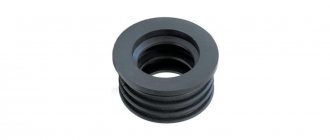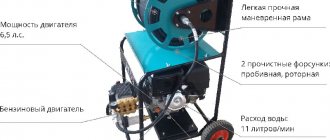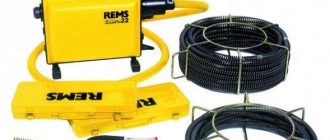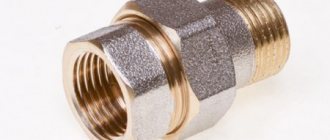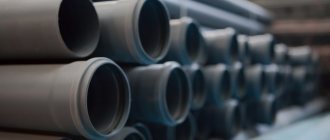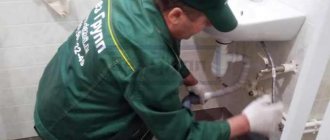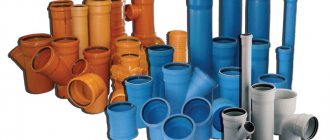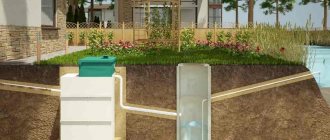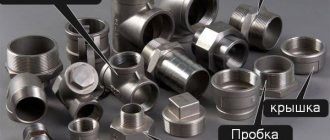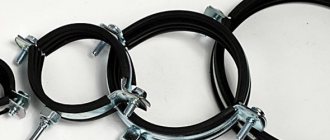One of the important communication systems is the drainage design, the reliable functioning of which determines the quality and comfort of living in the house. Thanks to a wide selection of materials and fittings for connecting various sewer pipes, you can assemble the system yourself.
Sewage is needed to remove dirty water and human waste products from the home. Without such a system, it is impossible to operate a residential premises.
Output of the sewer system under the toilet
Material orientation
When starting serious work - choosing an option for joining sewer pipes, it is important to find out in advance what material you will have to deal with.
Today the following products are used in drainage systems:
- made of PVC (polymer);
- cast iron;
- become;
- concrete;
- ceramics;
- asbestos cement;
- corrugations.
The first two types of material are most often used, while the others are quite rare. Corrugated pipes are in demand in external pipelines of private buildings or as components of networks of large production facilities.
Cast iron pipes are used in external drainage systems. Compared to steel ones, they are quite heavy, so they are not suitable for internal sewerage, especially if they are installed by one person. But at the same time, cast iron pipes are not afraid of corrosion, like steel ones, and have a long service life, and are also in demand in heating systems, in particular, when installing risers. Although not every person will connect complex elements in cast iron pipes. The disadvantage of such products is the regular adhesion of waste inside the pipe due to the uneven surface. In winter, during the heating season, they are more susceptible to clogging. Compared to them, polymer products are more practical.
Heating cable to the sewer
In some areas with particularly harsh weather conditions, sewer pipes require additional insulation, which will help prevent the system from freezing. For this purpose, polystyrene foam, polyethylene foam, isover and other heat-insulating materials are used. Rolled materials are not suitable for underground pipelines; for these purposes, only molded insulation materials are used, which are placed on the pipes before they are joined.
But sometimes such measures are not enough, then a heating cable is laid under the insulation. During the cold season, the cable is connected to the power supply and heats the pipe, preventing the liquid in it from freezing. Installation of the cable is possible both outside and inside the pipe - in both cases it is fixed along the pipe, although sometimes, for external use, the cable is wound around the pipe in the form of a spiral.
To secure the cable, tie tapes, a bandage or heat-resistant tape are used, the main thing is that these elements can withstand high temperatures well. If it is necessary to thread a cable into an already mounted and laid pipeline, a tee is cut into the system, and the cable is inserted through the resulting hole.
Plastic pipes: advantageous connection
Recently, products made from polyvinyl chloride are at the peak of popularity, displacing metal analogues, which in their technical parameters are significantly inferior to plastic ones. The main feature of plastic pipes is softening at elevated temperatures and returning to their original state at low temperatures (read: “Options for connecting sewer plastic pipes - advantages and disadvantages of methods”).
To understand how to connect plastic sewer pipes, you need to consider the positive arguments in their favor:
- anti-corrosion properties, thanks to which PVC products can be safely laid underground without additional insulation and at the same time save significantly;
- chemical resistance to substances and aggressive environments;
- low weight of plastic pipes;
- excellent throughput due to the smooth internal surface;
- service life, which can reach 100 years;
- easy installation that allows you to build any type of drainage system.
The downside to using PVC pipes is limited throughput. Although this drawback can be completely resolved if you choose a larger pipe. Knowing the diameter and length of the product, it is easy to select parts for the plastic sewer network. Knowing theoretically how to connect two pipes of different diameters, you can begin practical actions.
This type of pipe is also successfully used for external sewer networks. At the same time, in bitter frosts, you need to pay attention to thermal insulation, for example, purchasing soft insulation.
Advantages of polymers
As noted earlier, polymers are most often used in the pipe production process. The main advantage of this material lies in its ability to soften. That is, under the influence of high temperatures, the polymer becomes soft. As soon as cooling occurs, it returns to its original state. Other advantages of polymers are worth noting:
- Resistance to corrosive processes.
- There is no need to insulate the pipe that will be laid in the ground.
- Resistant to aggressive environments and chemicals.
- Smooth inner surface to prevent clogging.
- Low weight.
- The ability to arrange engineering communications of almost any complexity due to convenient installation.
- Long service life.
example
The only disadvantage of polymer is considered to be limited throughput. However, this unpleasant moment can be eliminated by selecting a pipe with a larger diameter.
Fittings play an important role in connections. With the help of these connectors, the system is sealed and does not allow unpleasant odors to enter.
Joining of PVC pipes for sewerage, fittings
Often at home, plastic pipes are joined together using fittings. These are a kind of connectors that ensure the tightness of the structure, eliminating the penetration of dampness and unpleasant odors from the system. Thanks to the wide range of these products, repair work is facilitated and worn-out elements are replaced with new ones.
Let's look at how to connect sewer pipes using fittings.
The latter are classified into types that differ in:
- functions (intermediate or connecting fittings);
- structures (couplings, tees, turn signals, extensions, etc.);
- shape (straight, T- and L-shaped).
Using this classification, you can easily select the appropriate pipe material and explain to the store which fitting models you are interested in.
When inserting the pipe into the fitting, do not forget to first butt the rubber gasket.
Characteristics
Compared to traditional products, a flexible sewer pipe has several advantages:
- Possibility of connecting pipe products without fittings.
- On a complex or turning section, there is no need to use bends and tees.
- The flexibility of the channel makes it possible to form rather long sections into coils, which greatly facilitates their transportation and storage.
- The elastic material will not burst if deformed or accidentally hit.
- The corrugated surface provides low linear expansion.
Preliminary steps before connecting
How to connect sewer pipes that are components of a large system? The answer to this question involves several sequential actions.
First of all, you need:
- Prepare a drawing of the system. It is important to take into account the existing objects in the house or apartment to which it is planned to lay drainage pipes, for example, a shower room, a bathtub, a toilet.
- Determine where the pipes join the central riser, and this is where the fittings will be needed.
- Remember that pipes for private sector sewerage are classified into two types according to cross-sectional size: 110.50 mm. It is the latter option that will be the ideal solution for laying pipes for a shower stall, bathtub, sink, or washing machine.
Before purchasing drainage pipes, you need to calculate in advance the required footage of the material so as not to waste money on excess plastic. After all, these products cannot be damaged.
Among the connectors, the turning fitting is of great importance, designed for joining a siphon (a hose from a plumbing fixture) and a drainage pipe made of PVC or metal. Some specialists neglect this connecting element, and in vain. After all, its absence can break the tightness of the system, and the joint will constantly let water through.
In order to ensure the longevity of the functioning of the drainage system, it is necessary to note certain nuances:
- Provide a specific slope of the pipes, which is calculated taking into account the amount of reduction - no more than 2-3 cm/m of the product. This indicator is needed for rapid removal of liquid.
- When arranging the pipeline, start from the plumbing to the central riser so that in the future the joints do not interfere with the flow of liquid in the system.
Knowing how to connect sewer pipes at the initial stages, you can protect the system from possible leaks in advance.
Standards for sewer discharge
Before starting work on installing a sewer outlet, you must familiarize yourself with the required installation standards and rules, which are provided for in specialized documents.
According to SNiP 2.04.01 - 85, the sewerage outlet must comply with the following standards:
The laying depth must be below the freezing level for the corresponding region. If for some reason this cannot be done, then the outlet must be insulated. To do this, you can use any insulating material, for example mineral wool.
For uninterrupted operation of the sewer system, the pipe must have a slope. The optimal slope of the sewer pipe is 2 cm per 1 linear meter.
Installation of the outlet begins from the inspection well, which must be located at a distance of at least 3 meters from the house.
If there are several outlets in the house, then the minimum distance between them should be 0.4 m. It is not recommended to make more than 2 outlets. It is recommended that all plumbing fixtures be connected to one riser; for a house with a large area, two.
The main subtleties of laying external sewerage
Fittings are used when arranging intra-house or intra-apartment sewerage. The situation is completely different with the external system, which is installed on the site near the house. In this case, it is necessary to start with the construction of wells intended for water purification.
Having understood how to join drainage pipes, it becomes clear that the external system requires products of larger diameter.
It is imperative to take into account the fact that the diameter of the outer pipe should be slightly larger than the size of the sewer pipe. It is better to take material with a “reserve” than to change the entire drainage system when there is a desire to connect new plumbing fixtures.
Having completed the preparatory steps, you can begin the serious business of connecting sewer pipes. According to the types and joints of pipes, two connection options are distinguished: detachable and permanent.
How to connect metal sewer pipes
You can connect metal sewer pipes using one of these methods - welding and installation in a socket. Installation in a socket is usually used when connecting cast iron, while welded joints are used when connecting steel.
Connection of cast iron pipes
As mentioned earlier, they are connected using sockets. The sequence of such installation is as follows:
- The side of the cast iron pipe that is without a socket must be inserted into the socket that has already been installed.
- The gap between the inner edges of the sockets and the mounted tail side of the pipe should be sealed with flax tow. To do this, using a prepared special wooden spatula, hitting it with a hammer, hammer the wound first layer of tow into the gap of the socket. During work, you need to make sure that while filling the gap, the tow does not penetrate inside the pipe, because. this will lead to blockages over time. By the end of the work, 2/3 of the socket cavity should be filled with tow.
- The space that remains after compacting the tow should be filled with a compactor without any impregnation.
- The next step will be filling with cement mortar, which is prepared in a ratio of 9 to 1 (9 - cement, 1 - water). The resulting solution must be compacted with diligence in the socket, and then covered with a damp cloth. A wet rag is needed to prevent cracks from appearing in the cement while it dries. In addition to cement mortar, you can use bitumen mastic, asbestos-cement mixture or silicone sealant.
This method is used to connect cast iron structures to each other, but there are situations where it is necessary to connect cast iron to plastic. In such situations, special couplings and adapters should be used. They are designed to connect sewer pipes of different diameters or made of different materials.
In order to make a high-quality transition from cast iron to plastic, you should thoroughly clean and wipe the inner surface of the cast iron socket, and then apply silicone sealant to it. After this, the sealant must also be applied directly to the adapter, and then the adapter must be inserted into the socket. This connection will become airtight when the sealant has completely hardened.
Connection of metal sewer pipes video:
Steel pipe connection
When it is necessary to connect steel structures, welding is used. In this case, the important point will be high-quality and professional performance of the work, taking into account all the features of the process. But even if you decide to do everything yourself, buying a good welding machine and doing all the work correctly, you will still end up with a very unreliable design. The thing is that steel ones themselves are not very suitable for sewerage needs. In addition, welding seams will be extremely susceptible to corrosion compared to the rest of the surface. In other words, just by making a sewer system you already understand that it has weaknesses that will lead to leaks over time.
Naturally, in addition to welded connections, threaded connections can be used for steel ones. For example, the American fitting is the most popular of these connectors. It consists of 2 end switches connected by a union nut.
Joining of pipes using the detachable method
Such connections are classified into flange and coupling. For plastic pipes it is better to use the first option. To achieve excellent tightness, it is better to use cast iron fasteners and rubber gaskets in detachable connections.
Let's look at how to properly connect sewer pipes using flanges step by step:
- Cut the pipe very smoothly, without chamfers.
- Place the loose flange over the cut.
- Insert a spacer protruding 10 cm from the cut line.
- Place a flange on it and connect it to the mating fittings.
- Secure with bolts.
During repairs or installation of pressure/non-pressure systems, coupling connections are used.
For the system to function trouble-free, you need to:
- Before connecting the pipes to each other, cut off their ends at 90°.
- Attach the coupling to the joint so that it is located exactly in the middle of the connector.
- Make a mark on the pipes indicating the location of the coupling.
- Treat the ends of the pipes and the fitting from the inside with a special lubricant.
- Insert one of the pipes into the coupling until it stops.
- Join the pipes without distortion to form a single axis.
- Push the coupling onto the second pipe up to the previously made mark.
This detachable method is very convenient for disassembling the pipeline if necessary. When assembly is performed, great attention is paid to sealing the joint.
How to choose pipes and fittings for sewerage
Dimensions of corrugated double-layer pipe for sewerage.
Today, for sewerage installations, products made from polypropylene (PP) or polyvinyl chloride (PVC) are used. Installation of pipes intended for operation in the most severe conditions (underground, roadways, etc.) is carried out using two-layer corrugated products made of polyethylene (PE). To make it easier to identify pipes intended for external installation, orange (red) filler is added to them at the manufacturing stage. During manufacturing, special additives are added to such pipes to increase strength. The inner surface is very smooth, which helps to quickly wash out dirt. Standard sizes used in private housing construction are 110 and 160 mm.
Installation of internal communications pipes is carried out using gray products made from PVC and PP. These pipes have less strength, they are not designed to withstand external loads, so their use for outdoor work (laying underground, roads, etc.) is highly not recommended. The standard sizes most often found when installing sewer systems in a country house are 110, 50, 40 mm.
Installation of sewerage pipes is impossible without shaped elements. Modern plastic is a material that has made it possible to produce a large number of options for all kinds of connecting and transition parts. Shaped elements are produced for internal and external sewerage. Among the huge variety of products offered by manufacturers, the most commonly used products can be identified:
- bends: 90, 45, 30 degrees;
- tees;
- plugs;
- cross-shaped distributor.
One-piece types: nuances
Now let's figure out how to join sewer pipes using the one-piece method.
There are different methods, but here are the most common:
- "Into the bell" . According to the theory, a socket with a rubber ring is connected to the straight end of the pipe. Before starting work, all surfaces are cleaned and degreased, and the flat end of the pipe product must be chamfered. Before joining, both surfaces are treated with silicone grease, and if it is absent, with liquid soap or detergent, and then joined. In this case, the longitudinal axes of both products must coincide. The flat part is inserted into the socket no deeper than the previously made mark.
- Welding: socket or butt . According to the theory of the first option, using moderate pressure welding, the following are melted: the inner side of the socket of one pipe and the outer side of the smooth end of the other. If butt welding is done, then the ends of both pipes and the joint itself are melted. The latest technique allows you to understand how to connect pipes of the same diameter.
- Gluing . According to this method, the connecting ends are coated with a special glue. It is selected depending on the material of the pipes. For example, BF-2 is suitable for metal and plastic, epoxy adhesive is suitable for polymers and metal, grade 88N is suitable for rubber and metal.
Using fittings
Another option is to use fittings. They are relevant if the entire sewer system is small and there are no frequent turns. How to connect a siphon to a sewer pipe? The operation is carried out using the same method. Work in this direction cannot occur without silicone seals. If the pipe bends, it must be additionally secured, otherwise it will sag, violating the angle of inclination.
When it is necessary to change the sewer system, cast iron is often chosen, because it is difficult to use modern material for the transition. What kind of work do they do? It's good when they have bells. In this case, the assembly is carried out similar to folding a nesting doll. As soon as the smooth part is inserted into the socket, a gap will appear between the elements. To remove it, use a sealant. Linen tow is suitable for this.
To prevent joints from leaking, use cement mortar and fill the structure with it. It is not necessary to use just such a sealing system - there are other compositions. This includes bitumen, mastic, and sealants. Installation work will not be difficult.
Repair of internal sewerage
Connection diagram for internal sewerage pipes.
The situation is simpler if the work is carried out in a newly built house (premises). If there is an old sewer system, then you first need to dismantle it. It is good if the previously laid pipes are made of PP or PVC. Then you need to disconnect them and replace them with new ones. In this case, all slopes must be observed; if necessary, use sealant. The pipes are not joined all the way; the gap is needed to ensure thermal expansion.
If cast iron pipes were previously installed, the disassembly process will become somewhat more complicated. The main problem is to disassemble the tee without damage. This is much easier than replacing the part completely. First, you can try to hammer it out using a flat-head screwdriver and a hammer. This method is suitable if the cast iron was caulked using a heel or cement. But earlier, sulfur was also used as a “binder”. In this case, you will have to burn it out using a blowtorch or a torch connected to a gas cylinder. To do this, heat the plumbing part and the sulfur will gradually burn out. But do not forget to open the windows wide: the gas released by this chemical element is poisonous! Next, you need to use an adapter (rubber cuff plus clamps) to connect the cast iron tee and the plastic pipe.
Manholes
Linear ones are installed in straight sections of the sewer network.
The distances between them depend on the diameters of the pipes:
- for 150-600 mm – 50 m;
- 700-1400 mm – 75 m;
- more than 1400 mm – 150 m.
These values may be increased by no more than 10%. Each change must be properly justified.
Rotary lines are provided at those points where the lines change direction.
Nodes need to be laid where sewer lines connect. In one such well no more than 4 pipes should be connected - 3 inlet and 1 outlet.
Controls are required in areas where the courtyard sewerage network is connected to the street. They must be located outside the red building line. With their help, the operation of the sewerage network of specific sewerage facilities is monitored.
The slope of the terrain in different areas can change dramatically. Where collectors from different levels are connected, the fluid flow rate must be reduced. For this purpose, another type of well is provided - drop well. Wells - pressure absorbers are also used at the outlet of pressure pipelines from the pumping station .
Wells occupy a very significant share of costs. Thus, their cost can be up to a quarter of the costs required for laying pipelines. You can save on costs by combining the functionality of wells.
Pipes in manholes are connected by open trays. Moreover, where the lines are straight, the trays should also be straight, but at turns they should have a smooth curve. Turns in well trays by more than a right angle are unacceptable.
The procedure for connecting pipes in wells
The profile pipes are mated here according to two rules:
- according to the calculated water level;
- aligning the marks of the incoming and outgoing pipes.
If the water contents in pipes of the same diameter do not coincide, then they are connected “according to water levels.” This route is better in terms of the hydraulic operating conditions of the sewer network, but this requires laying the collector at a greater depth, which increases costs.
When there is a need to connect domestic sewerage pipes along shelygas (“shelyga to shelyga”), the hydraulic level must be checked.
In any case, the bottom of the outlet pipe tray should not be higher than that of the inlet pipe. To eliminate the possibility of backwaters, which result in intense precipitation, it is necessary to ensure that runoff from tributaries flows at a speed no higher than in the receiving main. If necessary, the speed from the connections must be reduced. For this purpose, differences are organized at the joints.
It is advisable to lay the sewer network running along driveways or streets parallel to the red building lines, and on the side of the street with the largest number of connected objects (buildings, courtyards or blocks).
If the route of the pavements does not allow laying under them, then the sewer network should be designed under their side space: sidewalks and lawns. The permissible deviation from the red line is 5 - 9 m.
Once again about the rules
- Products for installation must be free of mechanical damage (chips, cracks, dents are unacceptable).
- The fewer turns in the system, the more reliable the highway
- Be sure to ensure tight connections when making connections.
- It is forbidden to cut or shorten the bells
- The pipe cross-section is selected in accordance with the number of plumbing fixtures
- Horizontal pipes are laid at an angle
- The internal line should be fixed to the floor or wall
- Be sure to install ventilation
- Installation of "revisions" is necessary
- Installation of a riser with a horizontal pipe is prohibited at right angles
- Connection to plumbing is carried out with flexible hoses
- The external system should be insulated
- An inspection well is installed for every 15 meters of external sewerage.
If you follow all the rules for laying sewer pipes, the installation will be high-quality and durable.
